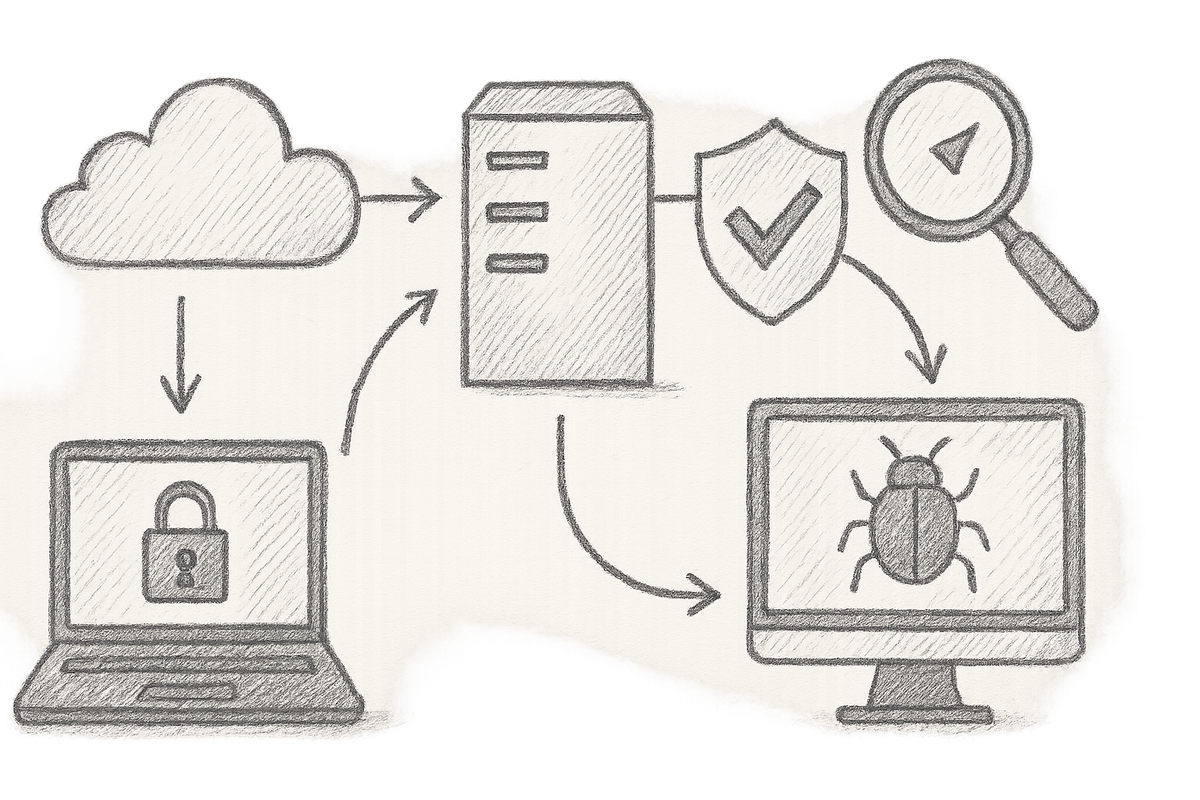Enterprise Endpoint Protection Solutions Uncovered: OpenEDR vs Velociraptor vs Elkeid for Scalable, Real-Time Threat Defence

Introduction: The Endpoint Protection Challenge in Modern Enterprise Settings
Why are 73% of organisations still leaving their endpoints exposed to devastating breaches in 2025? According to the 2025 Verizon Data Breach Investigations Report and corroborated by other industry analyses, this staggering figure highlights that it’s not simply about throwing antivirus at the problem anymore — that relic is yesterday’s news. Modern malware moves faster than a caffeinated squirrel and exploits sprawling hybrid clouds, containerised microservices, and Kubernetes clusters that seem to multiply faster than rabbits.
As a DevOps engineer, trying to tame this chaos while dodging alert fatigue and resource drain often feels like juggling flaming chainsaws — blindfolded. Open-source EDR tools such as OpenEDR, Velociraptor, and Elkeid burst onto the scene promising scalable detection, automated response, and forensic clarity. But spoilers ahead: picking the right one without triggering configuration nightmares or tanking your CPU is a minefield all its own.
Join me as I strip away the buzzwords, reveal real war stories from the trenches, and provide practical setup tips to keep your endpoints — and your sanity — intact. Spoiler alert: not all these tools were born equal, and the devil is hiding in the details...
Deep Dive into OpenEDR: Features, Deployment, and Practical Use Cases
OpenEDR brands itself as the Tony Stark of endpoint security — think fancy armour, smart sensors, and reflexes sharper than a hawk’s eye, all orchestrated by a central command. But is it too heavy to fly?
Architecture & Real-Time Detection
OpenEDR’s agent hooks deep into kernel events, performing behavioural heuristics backed by machine learning. Unlike signature matching dinosaurs, it aims to catch zero-days and lateral movements before you even know what hit you.
Let me set the scene: During a red team exercise in a hybrid cloud I was managing, a lateral movement attempt was detected within seconds. The automated isolation response? Spot on — the compromised node was quarantined before it could turn into a catastrophe. Trust me, that moment felt like watching a well-trained guard dog snap into action rather than chasing its tail.
Deployment Considerations
Supported across Windows, Linux, and macOS, OpenEDR requires delicate choreography. Without careful tuning, your SIEM will be flooded like a leaky boat with false positives. I’ve witnessed teams waste months battling noisy alerts — good intentions lost in a sea of overwhelm.
Tuning & Resource Utilisation
Brace yourself: OpenEDR can be resource-hungry. CPU usage spikes of up to 15% per host, memory consumption creeping up to a gigabyte, are not unusual as reported in recent user benchmarks and community reports. My advice? Start minimal, monitor telemetry obsessively, and unlock detection rules incrementally. Do not underestimate the power of suppression filters — they are your best friends in cutting noise.
Practical Tip
# Disable specific noisy detection rules in OpenEDR to reduce false positives
cat > disable_rules.conf <<EOL
rule_id: 1024
rule_id: 2048
EOL
# Apply configuration changes to OpenEDR agent
if opendr-agent-cli apply-config disable_rules.conf; then
echo "Configuration applied successfully."
else
echo "Failed to apply configuration. Check agent logs and retry."
fi
# Rollback tip:
# Keep a backup of your previous config. If issues arise, restore with:
# cp backup_disable_rules.conf disable_rules.conf
# opendr-agent-cli apply-config disable_rules.conf
Ignore this, and you’ll end up chasing phantom alerts like a ghostbuster in a haunted house.

Exploring Velociraptor: Threat Hunting and Digital Forensics Capabilities
Velociraptor is the Swiss Army knife of endpoint visibility: nimble, sharp, and surprisingly versatile. Powered by the Velociraptor Query Language (VQL), it slices through endpoint data with surgical precision.
Unique Selling Points
Forget rigid detection schemas. Velociraptor lets you craft forensic queries on the fly, hunting down stealthy fileless malware or living-off-the-land attacks lurking inside your Kubernetes nodes.
Here’s a ‘wait, what?’ moment: for environments where traditional EDRs fall flat, Velociraptor excels by enabling you to replay attack sequences from forensic snapshots — an invaluable feature often overlooked.
Deployment Architecture & Fleet Management
From single-host triage to enterprise-scale fleets managing thousands of agents, Velociraptor’s lightweight design keeps your resource budget intact: expect average CPU loads under 5% and memory footprints below 150MB, as detailed in the official Velociraptor documentation. That’s a far cry from the resource hogging in some competitors.
Incident Response Use Case
Once, during a Kubernetes compromise, we used custom VQL queries to extract process trees, network connections, and runtime container details within minutes. Hours saved on manual investigation — priceless when every second counts.
Sample VQL Query
# Find PowerShell processes spawned by kubelet, a suspicious pattern in Kubernetes environments
SELECT * FROM processes WHERE name LIKE '%powershell%' AND parent_path LIKE '%kubelet%'
Error Handling & Automation
Velociraptor’s CLI lets you schedule queries with built-in error handling. Got flaky network agents? The server queues and retries commands automatically — a lifesaver in the real world, where perfect connectivity is a myth.
Unpacking Elkeid: Host and Kubernetes Protection at Scale
Elkeid plays tough in mixed environments, bringing kernel-level monitoring and Kubernetes audit integration to the frontline.
Scalable Architecture
Managing thousands of endpoints? Elkeid’s centralised controller keeps an eye across them all, orchestrating anomaly detection and firing off automated responses. Ideal for sprawling Kubernetes deployments spanning multiple datacentres or cloud providers.
Key Features & Container Focus
Kernel hooks offer a deep dive into container syscalls, scrutinising suspicious behaviours. Combine that with Kubernetes audit logs, and you get correlated alerts on privilege escalations, container escapes, or broken network policies.
A ‘wait, what?’ cliffhanger: Elkeid does demand sharp tuning to prevent resource bloats, especially during container-heavy peaks. However, its auto-scaling policies come to the rescue, adjusting monitoring intensity dynamically.
Use Case
I once safeguarded a multi-tenant Kubernetes cluster where Elkeid’s anomaly detection flagged an escaping container exploiting a misconfigured network policy. Automated throttling and swift alerts thwarted what could’ve been a catastrophic breach.
Comparative Analysis: Deployment Complexity, Detection Accuracy, Resource Footprint, Scalability
| Feature | OpenEDR | Velociraptor | Elkeid |
|---|---|---|---|
| Installation Complexity | Moderate to High | Low to Moderate | High (due to Kubernetes) |
| Detection Types | Behavioural, Signature, Heuristic | Query-driven, behavioural | Behavioural, Kubernetes audit |
| Automated Response | Yes | Limited (manual/scripted) | Yes |
| Platform Support | Windows, Linux, macOS | Windows, Linux, macOS | Linux, Kubernetes |
| Resource Consumption | High (up to 15% CPU, 1GB RAM) | Low (5% CPU, 150MB RAM) | Moderate to High |
| Scalability | Enterprise-grade | Enterprise-grade | Enterprise-grade |
| Best Fit Use Cases | Real-time automated defence | Forensics & threat hunting | Multi-host, Kubernetes security |
Real-World Scenarios and Recommendations
Small-to-Medium Enterprise
If your ops team has limited muscle but craves mature protection, Velociraptor’s lightweight, scriptable approach is a no-brainer. Start small with focused artifact collection and scale as your team grows savvy. Trust me, you don’t want to bite off more complexity than you can chew here.
Large-Scale Hybrid Cloud with Kubernetes
Elkeid shines in Kubernetes native environments sprawling across clouds and data centres. Be prepared to invest effort in tuning, but the payoff? Automated anomaly detection that feels like having an extra pair of diligent eyes—without the coffee breaks.
Security-Focused Organisation
OpenEDR delivers rich behavioural rules and automated responses that pay dividends — if you can handle its appetite for resources and complexity. The tangling with configuration and tuning is real, but so is the payoff when it catches the stealthy stuff others miss.
If you want to sharpen your network-level discovery skills in complement to these endpoint tools, this Network Discovery and Web Application Security Uncovered resource is a great starting point. For those craving deeper vulnerability scanning insights, don’t miss Modern Vulnerability Scanning Solutions Uncovered: Nuclei vs OpenVAS Enterprise.
Future Trends: Emerging Directions in Endpoint Protection
- AI and ML will increasingly augment detection and response — but beware: vendor hype can often outpace reality.
- Expanding EDR coverage to Infrastructure-as-Code and cloud-native functions is imminent.
- Tighter Kubernetes runtime and audit log integrations are on the horizon.
- OpenTelemetry integration promises unified telemetry orchestration, bridging EDR and SIEM landscapes.
- Zero-trust paradigms will embed deeper into endpoint policy and automatic response models.
- Continuous learning platforms will adapt in real time to ever-evolving adversaries, raising the stakes and the bar.
Conclusion and Next Steps
OpenEDR, Velociraptor, and Elkeid each serve different masters on the endpoint battlefield. Your choice boils down to infrastructure complexity, team resources, and how battle-hardened your security posture already is. Don’t bite off more than you can chew: start small, fine-tune aggressively, and automate till your ops team cheers instead of groans.
Recommended starting points:
- Velociraptor official docs: https://docs.velociraptor.app/
- Elkeid community discussions on GitHub and forums (keep an eye on emerging Kubernetes security community sources)
- OpenEDR vendor and community forums (monitor for updated documentation and trial versions; note some sources are community-driven)
Nobody aces their first EDR deployment — it’s a grueling dance, not a beauty contest. Get your hands dirty, learn from each incident, and keep iterating relentlessly. Your endpoints — and your sanity — will thank you.
Cheers to less chaotic on-calls,
Your battle-scarred DevOps storyteller
References
- Verizon 2025 Data Breach Investigations Report – https://www.verizon.com/business/resources/reports/dbir/
- Velociraptor official documentation – https://docs.velociraptor.app/
- Kubernetes security best practices – https://kubernetes.io/docs/concepts/security/
- MITRE ATT&CK Framework – https://attack.mitre.org/
- OpenTelemetry project documentation – https://opentelemetry.io/
- Network Discovery and Web Application Security Uncovered resource – /network-discovery-and-web-application-security-uncovered-battle-tested-insights-and-practical-mastery-of-nmap-owasp-zap-nikto/
- Modern Vulnerability Scanning Solutions Uncovered article – /modern-vulnerability-scanning-solutions-uncovered-nuclei-vs-openvas-enterprise-battle-tested-comparison-for-devops-teams/
This guide isn’t just theory — it’s distilled from decades of wrangling production incidents, deploying bleeding-edge tools, and surviving the chaos of active attacks. Use these platforms wisely and your endpoints just might stay one step ahead of the next zero-day storm.



